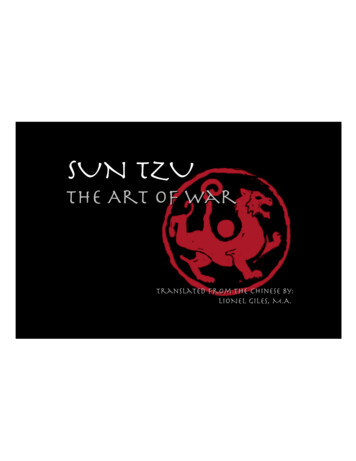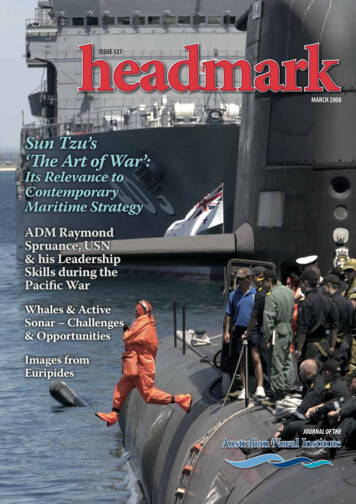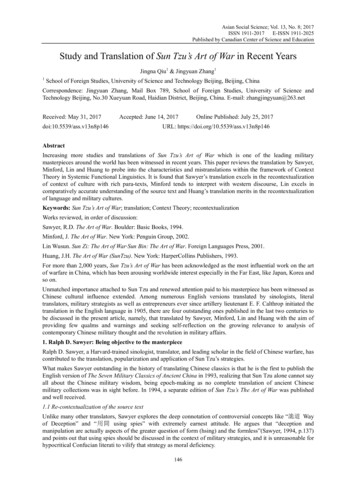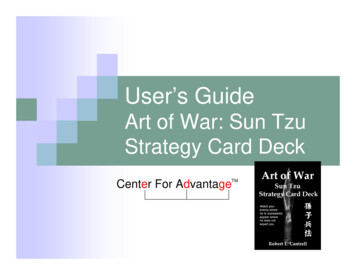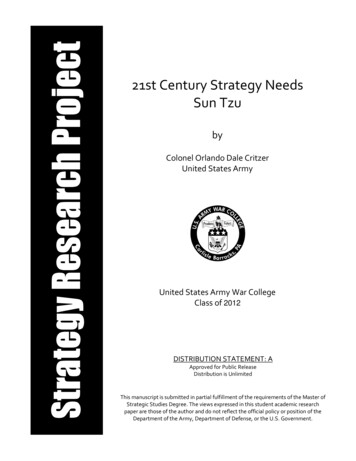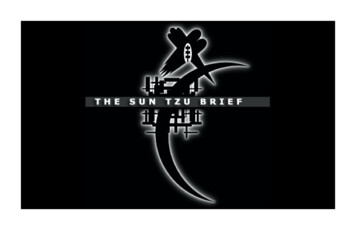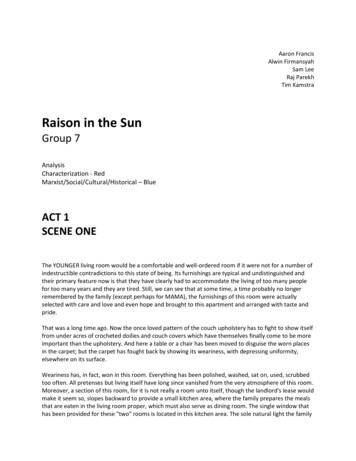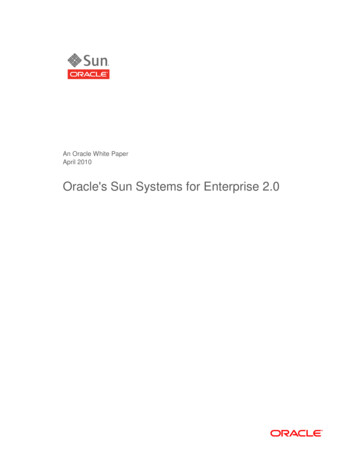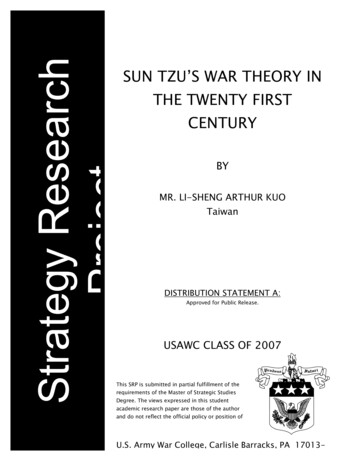
Transcription
SUN TZU’S WAR THEORY INTHE TWENTY FIRSTCENTURYBYMR. LI-SHENG ARTHUR KUOTaiwanDISTRIBUTION STATEMENT A:Approved for Public Release.USAWC CLASS OF 2007This SRP is submitted in partial fulfillment of therequirements of the Master of Strategic StudiesDegree. The views expressed in this studentacademic research paper are those of the authorand do not reflect the official policy or position ofU.S. Army War College, Carlisle Barracks, PA 17013-
Form ApprovedOMB No. 0704-0188Report Documentation PagePublic reporting burden for the collection of information is estimated to average 1 hour per response, including the time for reviewing instructions, searching existing data sources, gathering andmaintaining the data needed, and completing and reviewing the collection of information. Send comments regarding this burden estimate or any other aspect of this collection of information,including suggestions for reducing this burden, to Washington Headquarters Services, Directorate for Information Operations and Reports, 1215 Jefferson Davis Highway, Suite 1204, ArlingtonVA 22202-4302. Respondents should be aware that notwithstanding any other provision of law, no person shall be subject to a penalty for failing to comply with a collection of information if itdoes not display a currently valid OMB control number.1. REPORT DATE2. REPORT TYPE3. DATES COVERED30 MAR 2007Strategy Research Paper00-00-2006 to 00-00-20074. TITLE AND SUBTITLE5a. CONTRACT NUMBERSun Tzu’s War Theory in the Twenty First Century5b. GRANT NUMBER5c. PROGRAM ELEMENT NUMBER6. AUTHOR(S)5d. PROJECT NUMBERLi-Sheng Kuo5e. TASK NUMBER5f. WORK UNIT NUMBER7. PERFORMING ORGANIZATION NAME(S) AND ADDRESS(ES)U.S. Army War College,Carlisle Barracks,Carlisle,PA,17013-50509. SPONSORING/MONITORING AGENCY NAME(S) AND ADDRESS(ES)8. PERFORMING ORGANIZATIONREPORT NUMBER10. SPONSOR/MONITOR’S ACRONYM(S)11. SPONSOR/MONITOR’S REPORTNUMBER(S)12. DISTRIBUTION/AVAILABILITY STATEMENTApproved for public release; distribution unlimited13. SUPPLEMENTARY NOTES14. ABSTRACTSee attached.15. SUBJECT TERMS16. SECURITY CLASSIFICATION OF:a. REPORTb. ABSTRACTc. THIS PAGEunclassifiedunclassifiedunclassified17. LIMITATION OFABSTRACT18. NUMBEROF PAGESSame asReport (SAR)2019a. NAME OFRESPONSIBLE PERSONStandard Form 298 (Rev. 8-98)Prescribed by ANSI Std Z39-18
The U.S. Army War College is accredited by the Commission on Higher Education of the Middle StateAssociation of Colleges and Schools, 3624 Market Street, Philadelphia, PA 19104, (215) 662-5606. TheCommission on Higher Education is an institutional accrediting agency recognized by the U.S. Secretaryof Education and the Council for Higher Education Accreditation.
USAWC STRATEGY RESEARCH PROJECTSUN TZU'S WAR THEORY IN THE TWENTY FIRST CENTURYbyMr. Li-sheng Arthur KuoTaiwanColonel Alex CrowtherProject AdviserThis SRP is submitted in partial fulfillment of the requirements of the Master of Strategic Studies Degree.The U.S. Army War College is accredited by the Commission on Higher Education of the Middle StatesAssociation of Colleges and Schools, 3624 Market Street, Philadelphia, PA 19104, (215) 662-5606. TheCommission on Higher Education is an institutional accrediting agency recognized by the U.S. Secretaryof Education and the Council for Higher Education Accreditation.The views expressed in this student academic research paper are those of the author and do not reflectthe official policy or position of the Department of the Army, Department of Defense, or the U.S.Government.U.S. Army War CollegeCARLISLE BARRACKS, PENNSYLVANIA 17013
ABSTRACTAUTHOR:Mr. Li-sheng Arthur KuoTITLE:Sun Tzu's War Theory in the Twenty First CenturyFORMAT:Strategy Research ProjectDATE:26 March 2007KEY TERMS:VUCA, 4th Generation Warfare, Asymmetric WarfareCLASSIFICATION:UnclassifiedWORD COUNT: 5,611PAGES: 15War theories have great impacts on warfare. They provide ways to think about issues,and advice on problem solving regarding wars and use of force. Fundamentally, modern wartheories are based on cultures, observation of war behaviors, and technology. The core valuesof a war theory are still of the human dimension. Therefore, prevention of any armed conflictstill tends to be human nature of 20th century and will continue toward the 21st century with 4thGeneration Warfare. In accordance with "winning without fighting a battle" scenario, I will arguethat the battle-prevention theory school is the most suitable, and Sun Tzu's classic The Art ofWar is the best choice of approach. This paper will further discuss why Sun Tzu's theory is soprecious and applicable in terms of modern strategic environment and contemporary values ofhis sophisticated theory.
SUN TZU'S WAR THEORY IN THE TWENTY FIRST CENTURY“The art of war is of vital importance to the State. It is a matter of life and death, aroad either to safety or to ruin. Hence it is a subject of inquiry which can on noaccount be neglected”.Sun TzuThe Art of WarWar theories have a great impact on warfare. Usually they place things already known intosystems; provide ways to think about conflicts, and provide advice on problem solving regardingwars and use of armed forces. Many people believe that once a theory no longer applies or fitsthe situation, a new theory emerges to supplement or replace it.1 Generally, modern wartheories are based on strategic cultures, historical lessons learned by observing war behaviors,and technology. As history progresses, the core values of war theory are still part of the humandimension.It was early 1918 in the Western European Theater of the Great War. A young Americanaviator was flying his French-made biplane over countryside near French-German border.Underneath, a young, anxious, British infantryman standing up in a muddy trench line waswaiting a signal whistle to assault their opponent’s well defended positions. At the samemoment, one of his exhausted German counterparts, in the same type of trench just a mileaway, was fixing the bayonet on his Mauser against the enemy’s upcoming attack. Were bothparticipants of the trench fight able to predict what the future types of land warfare would lookslike in the jungles of Burma and in the dry desert of the Middle East decades later? Could boththe British and their German counterparts foresee how a totally different type of warfare calledthe “Cold War” would dominate the course of human history for half century? Could theGerman soldier believe their “Yellow Gas” –the weapon of choice– would remain on everynation’s agenda for almost a hundred more years and have an attentive name of “Weapon ofMass Destruction” (WMD)? Could that young American pilot visualize that, in early nextcentury, his fellow offspring would be ambushed by a group of un-uniformed, poor-equippedterrors named Al Qaeda in Afghanistan, and would engage in series of fierce streetfihgts amongShiite and Sunni sanctuary extremists, and radical insurgents in Iraq who are favorably usingImproved Explosive Devices (IEDs) against Americans and their coalition partners? I wonderwhether any of war theories could best tell them how future warfare is all about, and how toproperly deal with it at that moment. Thus it is probably still too early for us to define what thebest war theory is for the Twenty-first century. If not, we may have possibly been trapped into
the technology-driven myth, because we will never realize how far technology may go beyondour imagination.Certainly, war is fought by human beings, not by machines or technology, although theymay be decisive factors. After thousands of year, human nature remains essentiallyunchanged. The core of war theory is still based on the dimensions of human values, that is,how we look at and think of war. The first five decades of the Twentieth century left a history ofbloody fighting and inhuman annihilation generated by wars. Weapons of overwhelming effecthad thoroughly terrified mankind. The post-World War II situation of poverty, depression, anddisturbance had further persuaded people that there are no winners in war. This explains whythe United Nations (U.N.) was founded right after WWII. The U.N. is central to global efforts tosolve problems and to prevent further armed conflicts that challenge humanity.2 Therefore, theprevention of any armed conflict tends to derive from human nature in the late Twentieth centuryand will continue into the Twenty-first century.Describing the theory which best explains the nature and conduct of war for this century, Iwill argue that the battle-avoidance theory school is the most appropriate one, and that SunTzu’s classic The Art of War is the theory of choice in the twenty-first century. Using historicallessons learned in the twentieth and early twenty-first centuries, this paper will further reviewand discuss the values and applications of Sun Tzu’s war theory in terms of the historical cases,modern strategic environment, and contemporary values.3Historic overview of Sun TzuThe name Sun Tzu (“Master Sun”) is an honorific title bestowed upon Sun Wu, the authorof the Sun Tzu Ping Fa (The Art of War). According to Chinese tradition, Sun Tzu was amember of the “Shi” (intellect) during the consolidation of the Spring and Autumn Period(represented an era in Chinese history between 722 BC and 481 BC). He worked as amercenary strategist (similar to a modern contracted military consultant or chief personaladviser) for King Helü of the Wu State (one of the 170 states during the Spring and AutumnPeriod) after finishing his thirteen chapters of military dissertation, known as the Sun Tzu’s TheArt of War.During the Spring and Autumn Period on ancient China, the sovereignty of royal ZhouDynasty (1066 BC 221BC) had become so decentralized that the weakening emperors of Zhoucould no longer maintain their legitimate authority over subordinate states. All the kings ofstronger states were attempting to become the hegemon in China. Although significant politicalstruggles, large scale bloody armed conflicts, and brutal annexation often occurred among the2
states, the slow crumbling of Zhou nobility ironically resulted in widespread literacy andencouraged freedom of thought and technological advancement for the Chinese. On one hand,the overall strategic environment during the Spring and Autumn Period was extremelycomplicated and confusing because of various interests of states and the non-state players, i.e.the group of “Shi” (including the famous Confucius) who always promoted their thoughts andstrategies, sought for chances to rise, and benefited from inter-state political confrontations. Onthe other hand, in order to win brutal battles over their opponents and achieve the politicalambitions, most of the kings had to wield their national powers to invent new weaponry, rapidlybuilding up armed forces, organizing political alliances, and creating coalition partnerships. Thisenvironment, similar to modern times, would further provide great opportunities for the militarystrategists and thinkers, including Sun Tzu himself, to put their military thoughts and theories ofwar in practice.Sun Tzu’s The Art of War is a concise statement (fewer than forty pages in most ofEnglish translations, or 6,600 characters in the original Chinese text) on strategy written insympathy style of Chinese classical writings. The subjects of these famous thirteen chaptersare as following4:1. Estimates2. Waging war3. Offensive strategy4. Dispositions5. Energy6. Weaknesses and strengths7. Maneuver8. The nine variables9. Marches10. Terrain11. The Nine Varieties of ground12. Attack by fire13. Employment of Secret agentsIn history, Sun Tzu’s work had been rewritten and further interpreted and explained byseveral Chinese military commanders, strategists, and scholars. Among them, the most famousone was Tsao Tsao, a Chinese general and later an emperor about A.D.200. As Chineseculture had spread out all over the Eastern Asia, military thinkers and worriers of Japan andKorea were believed deeply influenced and persuaded by Sun Tzu’s war theory. Not until the3
late Eighteenth century were Sun Tzu’s writings introduced to the Western world. The first timeSun Tzu’s The Art of War translated into a European language was in 1782, by French JesuitJean Joseph Marie Amiot. Since then, it has been translated and published in more than thirtydifferent languages.Sun Tzu possibly influenced Napoleon and even the war planners of Operation DesertStorm in 1991. In addition to its impacts on military professionals, leaders as diverse as MaoZedong, Vo Nguyen Giap, and General Douglas MacArthur and General Colin Powell havedeclared to have drawn inspiration from the work. It was also on the reading list of generalTommy Franks, the commanding general of U.S. Central Command, who was responsible forplanning and execution of both Operation Enduring Freedom in 2001 and Operation IraqiFreedom in 2003.5 B. H. Liddell Hart, the great British strategist and thinker, described Sun Tzuas the most concentrated essence of wisdom on the conduct of war, and only Clausewitz iscomparable; but “the clarity of Sun Tze’s thought could have corrected the obscurity ofClausewitz.”6 He found many other points from Sun Tzu’s The Art of War that coincided with hisown lines of thought, particularly Sun Tzu’s constant emphasis on doing the unexpected andpursuing the indirect approach in strategy—avoiding the enemy’s strength and probing forweakness—Liddell Hart’s most well-known assertion. At the end of his foreword to Griffith’stranslation, Liddell Hart also suggested “Sun Tzu is the best short introduction to the study ofwarfare, and no less valuable for constant reference on extending study of the subject.”7 Evenso, Sun Tzu’s war theory is also very popular with business people nowadays in private sector,and strategists for team sports and political campaigns.Twenty-first Century’s Strategic Environment:“You are living in the period of time that will produce more change for humanitythan any previous era in history. It is a time of extraordinary importance that willfundamentally reshape almost every aspect of your life during the next twodecades. Wholesale change is taking place in almost every segment of yourreality-and the pace will only increase in the coming years.”8John PetersonThe Road to 2015As we are entering the twenty-first century, the potentials for armed conflict among nationstates remain as serious challenge and difficult issues to address. In the face of the best effortsof many, differences in wealth, technology, and information create unstable conditions amongnations. Additionally, the influences and powers of non-state actors have are increasing theirregional and worldwide implications. Oftentimes, nations, non-state actors, and transnational4
entities compete in the diplomatic, informational, military and economic (DIME) arenas of themodern strategic environment.Since the end of WWII, the world has extensively and rapidly changed. Uncertainty is thedefining characteristic of the current strategic environment. We identity trends but cannotpredict specific events with precision.9 On one hand, the most obvious political changes are thecreation and growth of international organizations, and non-state players that influence theinternational scene.10 Colin S. Gray points out the statecraft and war have several levels:political, strategic, operational, and tactical.11 These levels overlap; their boundaries aresometimes so vague that they are not easy to clearly define. Failure at any level may negativelyaffect the other levels of war and lead to total defeat for a nation. On the other hand, the mostremarkable technological change is information. All sectors of society are becoming networkedon an international scale. One actor, behind the scenes, is able to remotely and swiftlymanipulate all players on stage by way of computer based networks.Under such constantly changing and irregular circumstance, we can best describe thestrategic environment as volatile, uncertain, complex and ambiguous (VUCA). This environmentis very similar to the Chinese Spring and Autumn Period 2,500 years ago when Sun Tzucompleted his classic war theory in an effort to prevent war among various players. Today, inthe changing age, the new face of Twenty-first century warfare is Fourth Generation Warfare(4GW). This type of warfare uses all available networks—political, economic, social, andmilitary—to convince the adversary’s political decision makers that their strategic goals areeither unachievable or too costly for the perceived benefit.12 This works in concert with SunTzu’s battle-avoidance war theory, and provides opportunity for its further demonstration andverification.Accordingly, the current strategic environment resemble closely how it was two thousandyears ago in China’s Spring and Autumn Period. Since the core values of contemporarywarfare remain unchanged from those of ancient China, of which had proved effective andvaluable during the time of Sun Tzu will also contribute them to modern warfare as well.Contemporary Values of Sun Tzu’s War Theory:Winning without fighting a battle: the battle-avoidance theory“Generally in war the best policy is to take a state intake; to ruin it is inferior tothis. To capture the enemy’s army is better than to destroy; to take intact abattalion, a company or a five-man squad is better to destroy them. For to winone hundred victories in one hundred battles is not the acme of skill. To subduethe enemy without fighting is the acme of skill.”5
Sun TzuThe Art of WarSun Tzu’s work covers all levels and spectrum of war. It provides fairly simple butapplicable guidance from tactical aspects for the commander in the battlefield for waging war tostrategic deliberations in the council chambers as to whether or not to wage war.13 Althoughthis classic book does not offer cookbook approaches, today’s war planners are still able togenerate their course of actions from grand strategy and national security strategy, down tobattlefield tactics by following Sun Tzu’s theory. The most significant point is “winning withoutfighting a battle.”At the tactical level of war, it is very difficult to explain to soldiers how a rifleman candestroy his target without firing a bullet. At higher levels, however, this smart principle mayprovide more valuable thinking and workable options to the decision makers who are in controlof both soft-powers and hard-powers. They will better use all elements of national power, theDIME, to achieve the nation’s goals. The Cuban Missile Crisis in 1962, the Haiti Crisis in 1994,and the Taiwan Straits Missile Crisis in 1996 were all excellent examples supporting Sun Tzu’s“winning without fighting a battle” assertion. This also echoes today’s U.S. military favoritedoctrine for effects-base operations.In the first chapter of his book, Sun Tzu warned that, “War is a matter of vital importanceto the state; the province of life or death; the road to survival or ruin. It is mandatory that it bethoroughly study.”14 Because of its importance, Sun Tzu also asserted that calculations areessential and necessary before the war is waged. The word “calculations” is better translatedas “estimates” especially at operational and strategic levels. If estimates indicate the plan is notworkable or too risky, then, the decision maker should not take any of necessary actions beforeall issues of risks are properly solved out. If not, he will put his force in jeopardy and will ruin hisnation.The case of the German invasion of the Soviet Union in July 1941 provides concreteevidence of how the failure of calculations can significantly influence the outcome of wars oroperations. After Western Europe had fallen into the hands of Nazi Germany, Adolf Hitler waswilling to turn his deadly war machine toward the Soviet Union. He then launched the famousOperation Barbarossa against Stalin. Strategically, with limited Nazi German resources, Hitlercommitted the fatal mistake by opening two separate fronts simultaneously against the Alliedand Soviet Union. Nevertheless, the logistics estimate of the German general staff had advisedhim before the operations that German supply limit would be only pushed to the east of Kievand Lokhvitsa, and could not sustain German’s line of objectives (see graphic below). Hitler’s6
illogical determination and highly risky action not only resulted in the failure of OperationBarbarossa, but also predestined the extinction of the Third Reich.15(German anticipated supply limit of Operation Barbarossa, 1941)Attack enemy’s strategy, and then disrupt his alliances.“Thus, what is of supreme importance in war is to attack the enemy’s strategy.Next best is to disrupt his alliances. The next best is to attack his army. Theworst policy is to attack cities. Attack cities only when there is no alternative.” 16Sun TzuThe Art of WarWhen war is unavoidable, Sun Tzu taught us how to best win it. In his book he assertedthat “the best way to conquer the enemy is to attack his strategy.” This indicates that whenone’s strategies do not have significant benefits or advantages over the opponent’s strategies,he may still win a battle but will eventually lose the war. Doolittle’s bombing of the Japanesehomeland on 18 April 1942 had no significant tactical effect. Apparently, it was to attackJapanese major cities on their homeland in return to their sneak attack on U.S. military bases inPearl Harbor, 7 December 1941. Strategically, it was to disrupt and attack Japan’s nationalmilitary strategy and war plans by inserting sixteen U.S. Army Air Corps B-25 land-basedmedium bombers taking off from a navy aircraft carrier, the USS Hornet (CV-8), into theJapanese defense perimeter, which they perceived as water-tight. Led by legendary armyaviator Lieutenant Colonel James Doolittle, this bold action caused a negative physiologicaleffect on the Japanese far greater than the slight physical damage on bombing targets. It7
successfully unbalanced the Japanese strategic centers of gravity, and quickly forced theirmilitary planners to alter their entire war strategy. After the Doolittle Raid, the Japanesedramatically deviated from their previous courses of war, and shifted their operational centers ofgravity. Instead of going further south of Indochina region, they hastily attacked the Island ofMidway. At the end of the Battle of Midway, the formerly victorious Japanese Imperial Navy lostfour aircraft carriers and three thousand veteran aviators and seamen. It was not only greatlosses for Japan, but also was the turning point of the Pacific War which led to Japan’s totaldefeat at the end of WWII. This shows that, having achieved strategic superiority, we can winthe war without fighting necessary battles.(A B-25 bomber taking off from USS Hornet in April 1942)Another example regarding use of strategy is Operation Iraqi Freedom by the U.S.-ledcoalition forces in 2003. According to an interrogation after the war, the Iraqi strategicleadership repeatedly dismissed the threat of coalition forces staging in Kuwait posed toBagdad, instead; they viewed the Iranians as the number one external adversary. Iraqi leaderSaddam Hussein had initially calculated that he could maintain the ambiguity over his WMDprogram to deter the Iranians, his opponents at home, and other adversaries even as hecomplied with the letter of the U.N. inspection demands.17 Saddam’s “deterrence by doubt”strategy encouraged suspicions within the U.S. Bush administration that the Iraqi leadership didhave something to hide, and eventually subjected his regime to a total defeat by the U.S.-ledcoalition forces.Today, the significance of building and protecting friendly coalition, and attacking enemy’salliance during the war has no difference from the Chinese Spring and Autumn periods. When8
ones alliance or coalition has broken down, the nation fighting alone to win a war will have farmore difficulties. During the first Gulf war in 1991, both the Iraqi leadership and U.S. GeneralNorman Schwarzkopf precisely identified that the U.N. forces’ theater strategic center of gravitywas the coalition partnership. Launching his Scud missiles to attack Israeli built-up areas,Saddam Hussein intended to drag Israel into the fights. Once Israel struck back or joined theU.N. forces, Saddam Hussein could then instantaneously shift his war theme from invadingKuwait to the Israeli-Arab conflict. It would cause rapidly the Arab nations to leave the U.N.forces and dissolve the U.S.-led coalition. To counter Saddam’s strategy and maintain theexisting coalition, General Schwarzkopf had to deploy the U.S. Army Patriot missile units toprotect Israel from Iraqi ballistic missile attacks, and sent out elements of combined specialoperations force to hunt down Iraqi Scud launching facilities.Defeating Asymmetric Enemies“Now there are five circumstances in which victory may be predicted: he whoknows when he can fight and when he cannot will be victorious; he whounderstands how to use both large and small forces will be victorious; he whoseranks are united in purpose will be victorious; he who is prudent and lies in waitfor an enemy who is not, will be victorious; he whose generals are able and notinterfered with by the sovereign will be victorious.”Sun TzuThe Art of WarCarl von Clausewitz seemed to suggest that wars are fought only by nation-states; theTwentieth century’s history of warfare, however, has proved that wars can also be fought bynon-state actors against sovereign states, e.g. the Vietcong, the Irish Republican Army (IRA),the Palestine Liberation Organization (PLO), and Al Qaeda. Modern war can occur betweenconventional regular armies, between regulars and irregulars, and between irregular opponents.Sun Tzu’s “Chi” (the extraordinary force) and “Cheng” (the normal force),18 the same as LiddellHart’s direct and indirect approaches, best apply to all kinds of armed conflicts today,particularly when the weak attacks the strong.19 In his fifth chapter Energy, Sun Tzu furtherdescribed the relation between these two different elements as “that the army is certain tosustain the enemy’s attack without suffering defeat is due to operations of the extraordinary andnormal forces” and “In battle, use the normal force to engage, but use extraordinary force towin.”Traditionally, like the June 6 1944 Allied invasion of Normandy on the D-day, regularforces are usually the main efforts tasked to conduct decisive operations while irregular or9
extraordinary forces, such as French guerrilla organizations, U.S. Army airborne divisions andRanger battalions, are assigned the supporting effort to execute shaping operations in supportof the main effort. In the current changing strategic environment, smaller irregular forces mayplay more critical roles which decisively influence the outcome of war. Large scale regularforces will conduct other operations to fix or attrit the enemy in order to allow the smallerirregular elite forces to conduct decisive operations which will directly support the strategiccommander’s intent. This suggests the increasing importance of using unconventional forces,like Special Operations Forces (SOF), against crafty terrorists after the 9/11 attack in 2001.Nevertheless, military planners needed to realize that in modern warfare normal forces areoftentimes required to carry out irregular combat missions like their unconventional counterpart,and vice versa. In fact, more than sixty years ago his booklet On Guerrilla Warfare, the Chinesecommunist leader Mao Tze-Tung (1894-1975) had argued that “Orthodox forces may undercertain conditions operate as guerrillas, and the latter may, under certain conditions, develop tothe status of the former. However, both guerrilla forces and regular forces have their ownrespective development and their proper combinations.”20 It is believed that Mao wasprofoundly influenced by and followed Sun Tzu’s war theory during his guerrilla type campaign.In fact, he developed his strategy against the outnumbered Chinese Nationalist Army by wellutilizing Sun Tzu’s elements of “Chi” and “Cheng.” Mao’s campaign plan was clearly divided inthree phases: 1) political organization to seize initiatives; 2) conducting guerrilla warfare; 3)transition to regular operations to defeat enemy in decisive battles.21 Applying Mao’s uniquestrategy and using guerrilla type irregular forces, the Chinese Communist Party successfullydefeated General Chiang Kei-shak’s U.S.-equipped Nationalist Army in 1949, and establishedtheir communist regime—the People’s Republic of China (PRC)—in Beijing.Sun Tzu’s “Chi” and “Cheng” also refer to thinking unconventionally and acting irregularlywhile opposing threats like terrors and insurgents who usually utilize their asymmetric strengthagainst our weaknesses. These threats, by their nature, attempt to increase and capitalize onuncertainty and ambiguity by exploiting and countering their opponents’ technological andoperational advantages. Sun Tzu wrote that “those skilled at making the enemy move do so bycreating a situation to which he must conform; they entice him with something he is certain totake, and with lures of ostensible profit they await him in strength.” He also advocated initiativesagainst the asymmetric enemy by bring them to the battlefield, not to be brought by them.Facing challenge of the Global War on Terrorism (GWOT) and today’s 4GW, the U.S. strategicleaders must adapt critical and creative thinking to ensure their initiative and flexibility. This willfurther shape and create the strategic environment beneficial to us not the enemies.10
(President George W. Bush addressing on GWOT at the Citadel)In the speech to the cadets at the Military College of South Carolina (also known as theCitadel) in 2002, U.S. President George W. Bush put forth the challenge that the U.S. militarymust adapt different mindset in order to fight and win the long war. He clearly stated:“To win th
strategists and thinkers, including Sun Tzu himself, to put their military thoughts and theories of war in practice. Sun Tzu’s The Art of War is a concise statement (fewer than forty pages in most of English translations, or 6,600 characters in the original Chinese text) on strategy
